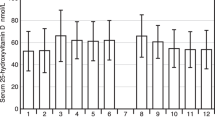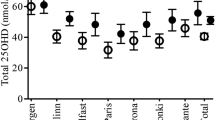Abstract
Summary
Vitamin D levels remained fairly stable during ageing with increasing levels in persons aged 55–65 years old and decreasing levels in persons aged 65–88 years old. The seasonal variation was larger than the longitudinal change. Our findings implicate that vitamin D supplementation becomes more important in older age groups and during wintertime.
Introduction
Longitudinal changes in serum 25-hydroxyvitamin D (25-OHD) levels during aging have not been studied extensively. Two studies showed increasing serum 25-OHD levels. One of these studies suggested that there might be decreasing levels in persons aged 65 years and older. The objectives of the current study are the following: (1) to examine longitudinal changes in serum 25-OHD levels in different age groups and (2) to describe the seasonal variation in different age groups.
Methods
Data of the Longitudinal Aging Study Amsterdam (LASA), an ongoing cohort study, were used. Two different cohorts were included: (1) younger cohort: aged 55–65 years old at baseline, n = 738, follow-up of 6 years and (2) older cohort: aged 65–88 years old at baseline, n = 1,320, follow-up of 13 years.
Results
At baseline, average levels were 56.5 nmol/L in the younger cohort and 51.1 nmol/L in the older cohort. In the younger cohort, a longitudinal increase in the mean serum 25-OHD levels of 4 nmol/L in 6 years was observed; in the older cohort, a longitudinal decrease in the mean serum 25-OHD levels of 4 nmol/L in 13 years was observed. The seasonal variation was ±12 nmol/L in the younger cohort and ±7 nmol/L in the older cohort.
Conclusions
Long-term serum 25-OHD levels remained fairly stable during aging with slightly increasing levels in persons aged 55–65 years old and slightly decreasing levels in persons aged 65–88 years old. On average, the seasonal variation was larger than the longitudinal change. Our findings implicate that vitamin D supplementation becomes more important in older age groups and during wintertime.



Similar content being viewed by others
References
Lips P (2001) Vitamin D deficiency and secondary hyperparathyroidism in the elderly: consequences for bone loss and fractures and therapeutic implications. Endocr Rev 22:477–501
van Schoor NM, Lips P (2011) Worldwide vitamin D status. Best Pract Res Clin Endocrinol Metab 25:671–80
Lips P, Duong T, Oleksik A, Black D, Cummings S, Cox D, Nickelsen T (2001) A global study of vitamin D status and parathyroid function in postmenopausal women with osteoporosis: baseline data from the multiple outcomes of raloxifene evaluation clinical trial. J Clin Endocrinol Metab 86:1212–21
Kuchuk NO, van Schoor NM, Pluijm SM, Chines A, Lips P (2009) Vitamin D status, parathyroid function, bone turnover and bone mineral density in postmenopausal women with osteoporosis in global perspective. J Bone Miner Res 24:693–701
IOM (Institute of Medicine) (2011) Dietary reference intakes for calcium and vitamin D. The National Academies Press, Washington, DC
Holick MF, Binkley NC, Bischoff-Ferrari HA, Gordon CM, Hanley DA, Heaney RP, Murad MH, Weaver CM (2011) Evaluation, treatment, and prevention of vitamin D deficiency: an Endocrine Society clinical practice guideline. J Clin Endocrinol Metab 96:1911–30
Ginde AA, Liu MC, Camargo CA Jr (2009) Demographic differences and trends of vitamin D insufficiency in the US population, 1988–2004. Arch Intern Med 169:626–32
Ahacic K, Parker MG, Thorslund M (2007) Aging in disguise: age, period and cohort effects in mobility and edentulousness over three decades. Eur J Ageing 4:83–91
Looker AC, Pfeiffer CM, Lacher DA, Schleicher RL, Picciano MF, Yetley EA (2008) Serum 25-hydroxyvitamin D status of the US population: 1988–1994 compared with 2000–2004. Am J Clin Nutr 88:1519–27
Ganji V, Zhang X, Tangpricha V (2012) Serum 25-hydroxyvitamin D concentrations and prevalence estimates of hypovitaminosis D in the U.S. population based on assay-adjusted data. J Nutr 142:498–507
Jorde R, Sneve M, Hutchinson M, Emaus N, Figenschau Y, Grimnes G (2010) Tracking of serum 25-hydroxyvitamin D levels during 14 years in a population-based study and during 12 months in an intervention study. Am J Epidemiol 171:903–8
Berger C, Greene-Finestone LS, Langsetmo L, Kreiger N, Joseph L, Kovacs CS, Richards JB, Hidiroglou N, Sarafin K, Davison KS, Adachi JD, Brown J, Hanley DA, Prior JC, Goltzman D (2012) Temporal trends and determinants of longitudinal change in 25-hydroxyvitamin D and parathyroid hormone levels. J Bone Miner Res 27:1381–89
Huisman M, Poppelaars J, van der Horst M, Beekman AT, Brug J, van Tilburg TG, Deeg DJ (2011) Cohort profile: the Longitudinal Aging Study Amsterdam. Int J Epidemiol 40:868–76
Passing H, Bablok W (1983) A new biometrical procedure for testing the equality of measurements from two different analytical methods. Application of linear regression procedures for method comparison studies in clinical chemistry, Part I. J Clin Chem Clin Biochem 21:709–20
Macdonald HM, Mavroeidi A, Fraser WD, Darling AL, Black AJ, Aucott L, O'Neill F, Hart K, Berry JL, Lanham-New SA, Reid DM (2011) Sunlight and dietary contributions to the seasonal vitamin D status of cohorts of healthy postmenopausal women living at northerly latitudes: a major cause for concern? Osteoporos Int 22:2461–72
van den Heuvel EG, van Schoor N, de Jongh RT, Visser M, Lips P (2013) Cross-sectional study on different characteristics of physical activity as determinants of vitamin D status; inadequate in half of the population. Eur J Clin Nutr 67:360–365
Stel VS, Smit JH, Pluijm SMF, Visser M, Deeg DJH, Lips P (2004) Comparison of the LASA Physical Activity Questionnaire with a 7-day diary and pedometer. J Clin Epidemiol 57:252–58
Fitzmaurice GM, Laird NM, Ware JH (2004) Applied longitudinal analysis. John Wiley & Sons, New York
Jones RH (1993) Longitudinal data with serial correlation: a state-space approach. Chapman & Hall, London
Bolland MJ, Grey AB, Ames RW, Mason BH, Horne AM, Gamble GD, Reid IR (2007) The effects of seasonal variation of 25-hydroxyvitamin D and fat mass on a diagnosis of vitamin D sufficiency. Am J Clin Nutr 86:959–64
Bolland MJ, Chiu WW, Davidson JS, Grey A, Bacon C, Gamble GD, Reid IR (2008) The effects of seasonal variation of 25-hydroxyvitamin D on diagnosis of vitamin D insufficiency. N Z Med J 121:63–74
Shoben AB, Kestenbaum B, Levin G, Hoofnagle AN, Psaty BM, Siscovick DS, de Boer IH (2011) Seasonal variation in 25-hydroxyvitamin D concentrations in the cardiovascular health study. Am J Epidemiol 174:1363–72
Bouillon RA, Auwerx JH, Lissens WD, Pelemans WK (1987) Vitamin D status in the elderly: seasonal substrate deficiency causes 1,25-dihydroxycholecalciferol deficiency. Am J Clin Nutr 45:755–63
Acknowledgments
This study is based on data collected in the context of the Longitudinal Aging Study Amsterdam (LASA), which is largely supported by a grant from the Netherlands Ministry of Health, Welfare and Sports, Directorate of Nursing Care and Older persons. We would like to acknowledge our colleagues from the laboratories of the VU University Medical Center in Amsterdam, Isala Klinieken (Weezenlanden) in Zwolle, and Ziekenhuis Bernhoven in Oss, Veghel, and Uden. Assessment of serum 25-OHD levels was supported in part by a research grant from the Investigator Initiated Studies Program of Merck & Co., Inc. The opinion expressed in this paper are those of the authors and do not necessarily represent those of Merck & Co., Inc.
Conflicts of interest
Dr. Lips served as a consultant for Merck. Dr. Lips and Dr. van Schoor received a research grant from Merck. Dirk Knol, Dorly Deeg, Frans Peters, and Annemieke Heijboer declare that they have no conflict of interest.
Author information
Authors and Affiliations
Corresponding author
Rights and permissions
About this article
Cite this article
van Schoor, N.M., Knol, D.L., Deeg, D.J.H. et al. Longitudinal changes and seasonal variations in serum 25-hydroxyvitamin D levels in different age groups: results of the Longitudinal Aging Study Amsterdam. Osteoporos Int 25, 1483–1491 (2014). https://doi.org/10.1007/s00198-014-2651-3
Received:
Accepted:
Published:
Issue Date:
DOI: https://doi.org/10.1007/s00198-014-2651-3




